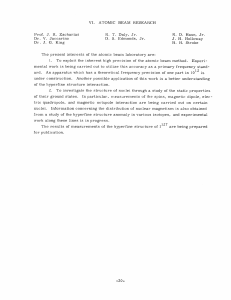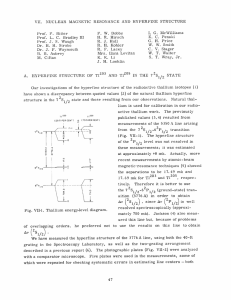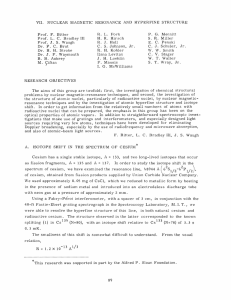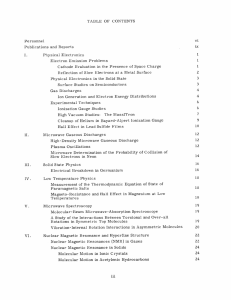I. G. McWilliams
advertisement
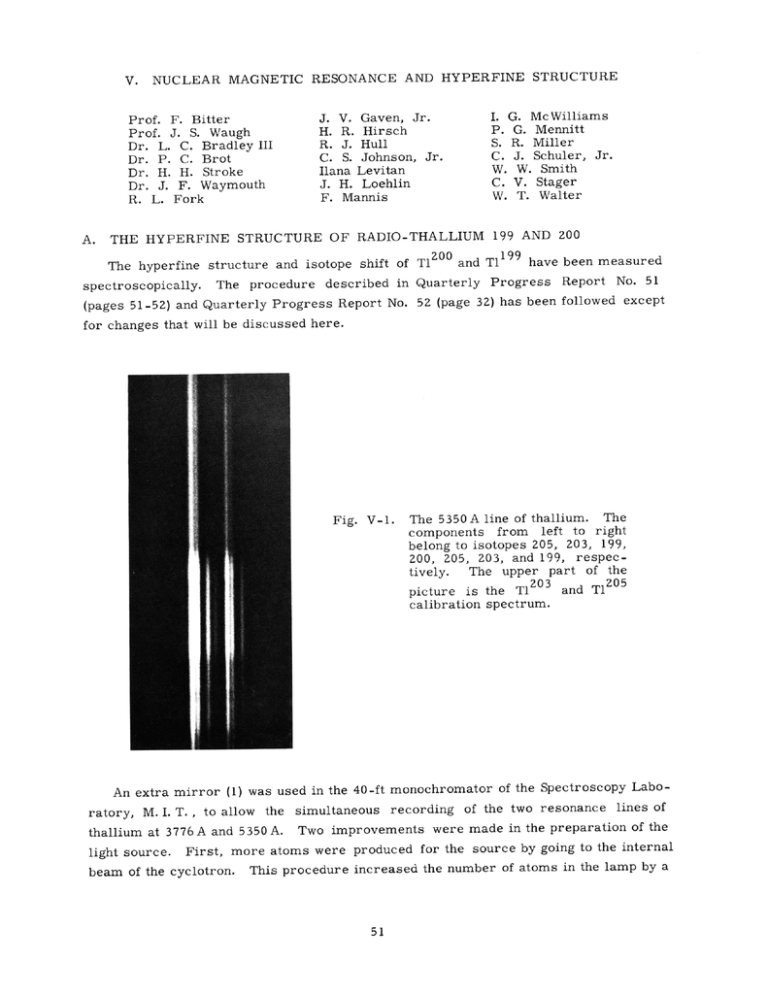
V. NUCLEAR MAGNETIC RESONANCE AND HYPERFINE STRUCTURE Prof. F. Bitter Prof. J. S. Waugh Dr. L. C. Bradley III Dr. P. C. Brot Dr. H. H. Stroke Dr. J. F. Waymouth R. L. Fork A. J. V. Gaven, Jr. I. G. McWilliams H. R. Hirsch R. J. Hull C. S. Johnson, Jr. Ilana Levitan J. H. Loehlin F. Mannis P. S. C. W. THE HYPERFINE STRUCTURE OF RADIO-THALLIUM G. Mennitt R. Miller J. Schuler, W. Smith Jr. C. V. Stager W. T. Walter 199 AND 200 19 9 have been measured The hyperfine structure and isotope shift of T100 and T1 spectroscopically. The procedure described in Quarterly Progress Report No. 51 (pages 51-52) and Quarterly Progress Report No. 52 (page 32) has been followed except for changes that will be discussed here. Fig. V-1. The 5350 A line of thallium. The components from left to right belong to isotopes 205, 203, 199, 200, 205, 203, and 199, respecThe upper part of the tively. picture is the T1203 and T1205 calibration spectrum. An extra mirror (1) was used in the 40-ft monochromator of the Spectroscopy Laboratory, M. I. T., to allow the simultaneous recording of the two resonance lines of thallium at 3776 A and 5350 A. Two improvements were made in the preparation of the light source. First, more atoms were produced for the source by going to the internal beam of the cyclotron. This procedure increased the number of atoms in the lamp by a (V. NUCLEAR MAGNETIC RESONANCE) Second, approximately 1 Cgm of indium in the form of indium chlo- factor of nearly 5. ride was placed in the lamp. It had been found experimentally that a small amount of such impurity in the lamp increased the useful life of the lamp appreciably. bration of the plates was improved by using an Osram thallium lamp. emitted by this lamp is The cali- The spectrum extremely stable and reliable for photographic work. to prevent overexposure of the radio-thallium spectrum, Finally, a rotating step sector was placed before the slit of the spectrograph. The measurements previously made on Tl 199 have been confirmed within an accu- racy of approximately 2 per cent. New data were obtained from a spectrogram isotopes in the green line (see Fig. V-1). of both This plate, just as the plate of the ultraviolet line, showed a single line for T 200; thus it is confirmed that its hyperfine structure is indeed less than the observed linewidth (~40 mk). small hfs separations that have been observed This is consistent with the extremely by means of resonance techniques in other odd-odd isotopes of thallium. atomic-beam magnetic- The measured isotope shifts between T1199 and T1205 are 164 mk and 177 mk for the ultraviolet and green lines, The corresponding values for T 200-T1205 are 148 mk and 169 mk. respectively. The accuracy of these results is approximately ±5 mk. R. J. Hull, H. H. Stroke References 1. K. K. Y. Li and H. Laboratory of Electronics, B. H. Stroke, Quarterly Progress Report No. 55, M. I. T. , Oct. 15, 1959, p. 60. HYPERFINE STRUCTURE IN THE 3P The hyperfine structure of Hg 97. Research LEVEL OF Hg 1 9 7 . 1 has been measured in the 31 accuracy than that obtained in previous spectroscopic work (1). level with greater The level-crossing and double-resonance experiments were used to obtain the hfs separations, and the isotope shift was determined by a magnetic-scanning experiment. The level crossing described in Quarterly Progress Report No. been identified as the intersection between the F = 15/2, 58 (page 101) m = 15/2 and has F = 13/2, m = 11/2 levels. This crossing occurs at a field whose proton-resonance 33,364.2±8.0 kc. A double resonance has been observed between the F= 15/2, m = 15/2 and F = 15/2, m = 13/2 levels with a radio frequency of 3053. 91 ± .02 netic field proton-resonance frequency is mc and a mag- frequency of 24, 268. 4 ± 4. 8 kc. With the use of magnetic scanning, the separation between the Hg 19 7 , F = 11/2 and Hg 1 98 levels at zero field has been measured as 19, 360 ± 130 mc. In order to use these data for the calculation of the Hg necessary to know the electronic g value of the necesar 3 P 1 level. 197 * hyperfine structure, it is Level-crossing experiments Levl-cossngexerient NUCLEAR MAGNETIC RESONANCE) (V. Table V-1. Hyperfine structure in the Quantity 3 197 * p1 level of Hg Value (mc) WL 18246 ± 14 WH 14236 ± 20 WI 2240 ± 130 A -2328.8 ± 1. 7 B -901 ± 13 Explanation of Symbols WL: The separation between the F = 15/2 and F = 13/2 levels at zero field. WH: The separation between the F = 13/2 and F = 11/2 levels at zero field. in relative to Hg 1 9 8 WI : 7 The isotope shift of Hg 1 9 A: The magnetic dipole interaction constant. B: The electric quadrupole interaction constant. Hg 1 9 9 and Hg 1 9 7 and a double-resonance experiment in Hg 19 8 lead to the value, 1. 4861 + . 00036. Table V-1 gives the numerical results pertinent to the hyperfine structure of Hg 197" The limits of error are three times the standard deviation of the individual measurements from the mean of the quantity. A much more detailed report of this work, together with an interpretation of the data in terms of nuclear moments, is contained in a thesis (2) that has been submitted to the Department of Physics and in a paper, based on the thesis, which will be submitted for publication to the Journal of the Optical Society of America. H. R. Hirsch References 1. A. C. Melissinos and S. P. ' nucleus; Isomeric isotope shift, Phys. Rev. 115, 130 (1959). 3 H. R. Hirsch, Hyperfine Structure in the P Level of the Twenty-Four Hour meric Hg 2. Isomer of Mercury 197, Ph. D. C. Davis, Dipole and quadrupole moments of the iso- 97 Thesis, Department of Physics, HYPERFINE STRUCTURE IN THE 3 M. I. T., 1960. STATE OF Hg 1 9 7 199 1 99 has The previously described experiment (1) on the hyperfine structure of Hg 197 9 . The value of the zero-field hfs been extended to the 65-hr half-life isotope Hg splitting is 23, 086. 37 ± 0. 02 mec. The error is the probable error obtained from a (V. NUCLEAR MAGNETIC RESONANCE) least-square fit of the data. Systematic errors have been estimated and are believed to be smaller than the probable error quoted here. C. V. Stager References 1. C. Report No. D. V. Stager, Hyperfine structure of the 3 P state of Hg l 99 , Quarterly Progress M. I. T. , April 15, 57, Research Laboratory of Electronics, 1960, p. 63. DIRECT MEASUREMENT OF THE HYPERFINE SPLITTING OF THE 3p1 LEVEL OF Hg 19 7 ' 3 The hyperfine interval F = 13/2-F = 11/2 of the P 1 level of Hg 97* (nuclear isomer; 23 hours, nuclear spin I = 13/2) was measured by the direct double-resonance 197* was prepared by bombardThe sample of Hg method developed by Kohler (1, 2, 3). half-life, ment of gold with deuterons and extracted by following the technique of Bitter et al. (4). The double-resonance experiment was made possible by the fortuitous coincidence of the P 1 and an level of Hg96 with the absorption filter cell, P 1 F = 13/2 level of Hg 1 9 7 . both of which contained Hg 196 We therefore used a lamp enriched to a value of 8. 5 per cent. The data obtained both at zero field and with weak magnetic-field sweep indicate that (a) the interval F = 13/2-F = 11/2 is 14, 234. 86 ± 0. 09 mc; (b) the value I = 13/2 of the nuclear spin is confirmed. P. C. Brot References 1. R. H. Kohler, Hyperfine structure of the 3 P 1 state of mercury by double- resonance methods, Quarterly Progress Report, Research Laboratory of Electronics, M. I. T. , July 15, 1956, pp. 20-21. 2. R. H. Kohler, Heavy absorption of a spectral line, Quarterly Progress Report No. 52, Research Laboratory of Electronics, M. I. T., Jan. 15, 1959, pp. 32-37. 3. R. H. Kohler, Detection of double resonance by frequency change: Application to Hg 2 0 1 (submitted for publication to Phys. Rev.). 4. F. Bitter, S. P. Davis, B. Richter, and J. radioactive mercury, Phys. Rev. 96, 1531 (1954). E. R. Young, Optical studies of
